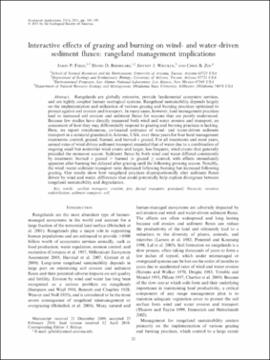| dc.contributor.author | Field, Jason P. | |
| dc.contributor.author | Breshears, David D. | |
| dc.contributor.author | Whicker, Jeffrey J. | |
| dc.contributor.author | Zou, Chris B. | |
| dc.date.accessioned | 2019-08-22T17:50:46Z | |
| dc.date.available | 2019-08-22T17:50:46Z | |
| dc.date.issued | 2011 | |
| dc.identifier | oksd_field_interactiveeffe_2011 | |
| dc.identifier.citation | Field, J. P., Breshears, D. D., Whicker, J. J., & Zou, C. B. (2011). Interactive effects of grazing and burning on wind- and water-driven sediment fluxes: Rangeland management implications. Ecological Applications, 21(1), 189-199. https://doi.org/10.1890/09-2369.1 | |
| dc.identifier.uri | https://hdl.handle.net/11244/321228 | |
| dc.description.abstract | Rangelands are globally extensive, provide fundamental ecosystem services, and are tightly coupled human-ecological systems. Rangeland sustainability depends largely on the implementation and utilization of various grazing and burning practices optimized to protect against soil erosion and transport. In many cases, however, land management practices lead to increased soil erosion and sediment fluxes for reasons that are poorly understood. Because few studies have directly measured both wind and water erosion and transport, an assessment of how they may differentially respond to grazing and burning practices is lacking. Here, we report simultaneous, co-located estimates of wind- and water-driven sediment transport in a semiarid grassland in Arizona, USA, over three years for four land management treatments: control, grazed, burned, and burned + grazed. For all treatments and most years, annual rates of wind-driven sediment transport exceeded that of water due to a combination of ongoing small but nontrivial wind events and larger, less frequent, wind events that generally preceded the monsoon season. Sediment fluxes by both wind and water differed consistently by treatment: burned + grazed > burned >> grazed >/= control, with effects immediately apparent after burning but delayed after grazing until the following growing season. Notably, the wind: water sediment transport ratio decreased following burning but increased following grazing. Our results show how rangeland practices disproportionally alter sediment fluxes driven by wind and water, differences that could potentially help explain divergence between rangeland sustainability and degradation. | |
| dc.format | application/pdf | |
| dc.language | en_US | |
| dc.publisher | Ecological Society of America | |
| dc.rights | This material has been previously published. In the Oklahoma State University Library's institutional repository this version is made available through the open access principles and the terms of agreement/consent between the author(s) and the publisher. The permission policy on the use, reproduction or distribution of the material falls under fair use for educational, scholarship, and research purposes. Contact Digital Resources and Discovery Services at lib-dls@okstate.edu or 405-744-9161 for further information. | |
| dc.title | Interactive effects of grazing and burning on wind- and water-driven sediment fluxes: Rangeland management implications | |
| osu.filename | oksd_field_interactiveeffe_2011.pdf | |
| dc.description.peerreview | Peer reviewed | |
| dc.identifier.doi | 10.1890/09-2369.1 | |
| dc.description.department | Natural Resource Ecology and Management | |
| dc.type.genre | Article | |
| dc.type.material | Text | |
| dc.subject.keywords | aeolian transport | |
| dc.subject.keywords | erosion | |
| dc.subject.keywords | fire | |
| dc.subject.keywords | fluvial transport | |
| dc.subject.keywords | grassland | |
| dc.subject.keywords | livestock | |
| dc.subject.keywords | resource redistribution | |
| dc.subject.keywords | sediment transport | |
| dc.subject.keywords | soil | |
